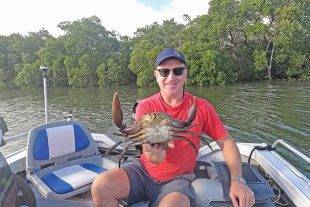WHILE many anglers focus on fishing in October, some turn their attention to mud crabs. As well as adding a degree of extra interest and excitement to the day, the rewards from a successful overnight soak of the pots are fantastic. Bundaberg mud crabs
Doing things right
For those who have never turned their hand to crabbing, a few easy basics will help you out. First, remember you’re allowed up to four pots per person in the boat in Queensland, with each float and pot marked according to the current regulations. Your float must be a minimum of 150mm diameter in all directions.Bundaberg mud crabs
The name of any minor under 18 with you, must be on the pots ‘assigned’ to them. If you choose to tie your pot to a fixed object rather than use a float, the pot must be tied off above the high tide mark and have a tag identifying the user above the waterline. A broad range of products are available when purchasing pots, with the range in price generally reflecting the quality of materials and ‘strength’ of the pot.Bundaberg mud crabs
Lighter duty pots are suitable for anglers doing a couple of trips each year, though it is worth investing in better quality gear if you’re looking at doing regular trips through the season.
Summary of crab pot regulations for tidal water in Queensland
- No more than four pots, dillies or a combination of both may be used per person
- There must not be more than four pots on a boat per person when on the water
- You must have an identification tag on your pot bearing the surname and address of the person using the apparatus
- All crab pots must have a light-coloured solid float attached when not tied to a fixed object, and the float must display the user’s name and not be less than 15cm in any dimension.
- When the pot is tied to a fixed object, a tag must be attached to a part of the rope above the high-water mark that identifies the user’s name
- A dilly for spanner crab fishing should be made of solid steel with a thickness of at least 6mm and not exceed 1m in each dimension
- Crab pots are not permitted in freshwater.
Size and possession limits of crab species for tidal water in Queensland
- Blue swimmer – 115mm minimum and possession limit of 20
- Mud – 150mm minimum and possession limit of seven per person or 14 per boat with two or more people on board
- Spanner – 100mm minimum and possession limit of 20 Bundaberg mud crabs
- Three-spot – 100mm minimum and no possession limit
Note, female mud crabs and blue swimmer crabs are no take. Egg-bearing spanner crabs and three-spot crabs are no take.
Best baits and locations
From my experience the best bait by far for mud crabbing would have to be fresh mullet frames. The oily flesh of mullet seems to travel well through the water and attracts crabs from far and wide. It is also easy to attach the frame to the inside of the pot using wire or clips through the eye socket.
If fresh mullet frames are not available, other successful baits include fresh fish and chicken frames. When planning a crabbing session, a bigger tide around a full and new moon are usually the best times because crabs become more active and scavenge across flats covered by the higher tide.Bundaberg mud crabs
Mangrove and mud-covered banks are good areas for muddies as well as deeper zones nearby. The presence of crab pot floats will often be a sign that a spot is holding. Be aware, a few people on the water may be happy to take your crabs, slash your pots to access your crabs if the pots are cable tied closed and even take your complete pot.
Unfortunately, it’s a risk we have to take. For this reason, many crabbers will drop their pots in and fish nearby, where they can keep an eye on them. The upper reaches of the Elliott, Burnett and Kolan rivers all hold mud crabs and are worth a shot in the Bundaberg area.Bundaberg mud crabs
I hope these tips help if you’re thinking of giving mud crabbing a go.
Brad Young.
 Bush ‘n Beach Fishing Magazine Location reports & tips for fishing, boating, camping, kayaking, 4WDing in Queensland and Northern NSW
Bush ‘n Beach Fishing Magazine Location reports & tips for fishing, boating, camping, kayaking, 4WDing in Queensland and Northern NSW









